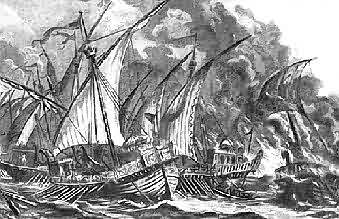
MARCH OF THE TITANS - A HISTORY OF THE WHITE RACE
CHAPTER 35 : THE SIXTH GREAT RACE WAR -
THE OTTOMAN HOLOCAUST
The Ottoman Empire was the longest lasting Nonwhite invasion of European soil ever. Lasting from the beginning of the 13th Century right to the start of the 20th, this group of mixed race Middle Eastern Turks, driven by a fanaticism molded in their Muslim religion, occupied vast stretches of central and southern Europe, twice being turned back at the very gates of Vienna in their attempts to seize all of Europe.
The impact and legacy of the Ottomans upon central and southern Europe was therefore vast, and crucial to any understanding of the racial and cultural mix which has made south eastern Europe the volatile place that it is.
THE RISE OF THE OTTOMANS
After passing through many hands during the course of history, by the end of the first Christian millennium, Asia Minor (modern day Turkey) was in the hands of the Eastern Roman Empire, later the Byzantine Empire.
The rise of Islam however created the first wave of Muslim nationalism, under the mixed race Seljuks tribe, who first emerged in a territory to the East of modern day Turkey.
The Seljuks soon set about seizing much of Asia Minor from the Byzantines, their new religion spreading far faster than Christianity amongst the by then very mixed races of the Middle East. By the beginning of the 13th Century, the Seljuks began to lose momentum.
Slowly fading from the scene, they were replaced by a new powerful Islamic force led by one Osman. His grouping began a policy of violent aggression towards the Christian outposts in Asia Minor - the followers of Osman became known as Osmanlilar (Turkish for "those associated with Osman"), or as they became known in the West, the Ottomans.

In 717 AD the Muslims under Caliph Velid, launched a furious attack upon Constantinople in an attempt to break the Whites. The Byzantines had however a secret weapon - so called Greek Fire, which appeared to have been some sort of early flame thrower. The exact secret of the Greek Fire was held so sacred that its composition was never betrayed to the outsiders and its secret preparation died with Constantinople. With the aid of Greek Fire, the Nonwhite army was defeated at the very gates of Constantinople. Here the Nonwhite fleet is destroyed in the Bosporus Straits by the Byzantine armies and their liquid fire.
THE GATES OF CONSTANTINOPLE REACHED - 1330 AD
After recapturing Constantinople in 1261 from the Fourth Crusaders, the Eastern Roman Empire, or Byzantines, tried to restore their power over the surrounding areas. In this they were badly hampered by the quickly spreading power of the Ottomans, whose forward units increasingly pushed home attacks on the outer fringes of the Eastern Roman Empire.
By 1330, the Ottoman Empire had piecemeal taken town after town, and had reached the Aegean Sea: Muslim forces stood in that year at the Bosporus straits, directly opposite Constantinople itself.
THE FIRST LANDINGS ON EUROPEAN SOIL - 1354 AD
Ironically, it was a Byzantine emperor who gave the Ottomans their first taste of power over European soil. An Ottoman detachment of soldiers was hired by a Byzantine emperor as a mercenary army to fight a rival claimant to the Byzantine throne. The Ottoman force simply stayed on once their paid for services were completed.
Launching a semi-independent war of their own, the Muslims seized and plundered the city of Gallipoli in 1354 - their first prize on the European side of the Dardanelles Strait. This was the first Turkish foothold in Europe, one they have kept to this day.
THE OTTOMAN INVASION OF BULGARIA - THE BATTLE OF KOSOVO
The Ottomans then seized the opportunity and poured troops in the beachhead. Marching straight into the Balkans, they defeated a Bulgarian army and then marched into Serbia, defeating that country's army at the battle of Kosovo in 1389.
The battle of Kosovo also became famous for one other event: during the battle, a normal act of war, a Serbian soldier killed the Ottoman emperor of the time, one Murad. After the battle was over, the Ottomans cruelly executed the captured Serbian prince, Lazar, as a reprisal.
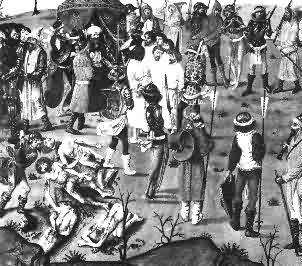
White prisoners being executed by the Ottomans after the Battle of Nicopolis in 1396. The White knights, drawn from all over Europe, could expect no mercy if captured by the invading Nonwhites, and thousands met their end in this way.
WHITE RESISTANCE FAILS - BATTLES OF NICOPOLIS AND VARNA
In 1396, a large expedition against the Ottomans in the Balkans, summoned by Sigismund of Hungary, drew White Christian armies from all over Europe.
They were however badly defeated at the Battle of Nicopolis (Nikopol) on the Danube River in that year. The Battle of Nicopolis was celebrated by the Ottomans with the massacre of all White prisoners taken - several thousand White soldiers were executed out of hand by the Nonwhite invaders in a bloodthirsty orgy lasting several hours.
Murad's successors kept on pressing further and further into Europe, meeting feeble White resistance along the way.
In 1439, Serbia was formally annexed to the Ottoman Empire and in 1440, the city of Belgrade was besieged, although it was not seized by the Ottomans at that time. In 1444, a renewed White Christian assault on the Ottomans was again defeated at the battle of Varna in Bulgaria.
This battle was vividly described in a letter from Aenas Sylvius Piccolomini, later Pope Pius II, to Filippo Maria Visconti, Duke of Milan, written immediately after the battle. :
"Our men did not shrink from joining battle, which began on the feast of St. Martin itself, 11 November 1444. So fierce and savage was the fighting that rarely could such a battle had never been fought between mortal men! For a long time its outcome was uncertain; it was contested with equal force by both sides. As long as our men fought for Christ and our opponents for Mohammed, enthusiasm for battle was such that fifteen thousand were wounded on each side.
"So long as the battle was equal, neither side wished to stop. The more blood that was spilled, the keener the hand-to-hand fighting.
"In the end both sides were drained of strength: limbs were so enfeebled that they had the strength neither to wield swords nor to bend bows. Both sides were thus forced to be still for the best part of an hour until their strength was resumed and their spirits returned. Then the battle was restarted. In the end the Turks won because they were more courageous, or because they were destined to win, or because they were greater in number.
"Those who escaped from the field say that no battle as bloody has been fought anywhere in Europe within the memory of our fathers. They also say that no fewer Turks than Hungarians fell, and, if the rumor is correct, eighty thousand men died in this battle."
The Nonwhite armies seemed invincible, and it seemed as if there was no stopping them advancing right into the heart of Europe.
THE JANISSARIES: THE "STOLEN WHITE CHILDREN" WHO BECAME THE OTTOMAN ELITE
One of the more remarkable ways in which the Ottomans kept their fighting strength up was through a unit of soldiers known as the Janissaries. The Janissaries were the Ottoman's elite forces - and they were also White.
One of the Ottoman leaders, Emir Orkhan (1326 - 1359), who was the first to occupy European continental soil, issued an edict to the conquered Europeans in the Balkans that they must hand over to the Ottomans 1,000 White male babies "with faces white and shining" each and every year. The youths were brought before the Ottoman sultan, and the best of them - in terms of physique, intelligence, and other qualities - were selected for education in the palace school. There they converted to Islam, became versed in the Islamic religion and its culture, learned Ottoman Turkish, Persian, and Arabic, and were compelled to serve the Ottomans, with their origins being concealed from them. They became the best and most trusted armed unit within the Ottoman Empire- a supreme act of irony.
This yearly tribute - reminiscent of the demand by the Moors for White virgins from the unfortunate Goths in Spain - was continued for an astonishing 300 years until 1648, during which time not only were 300,000 Whites absorbed into the Ottoman hierarchy (and for the greatest part also into the Turkish elite's bloodstream) but the Janissaries became known as one of the most efficient soldiers in the world.
It is no exaggeration to say that they sustained the Ottoman Empire in Europe for much of its existence, playing a not inconsiderable role in many of the great victories of that Empire.
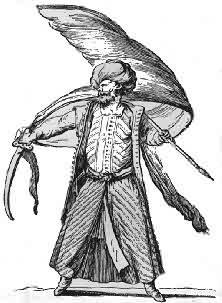
A fine woodcut of a Janissary - one of the stolen White children the Nonwhite Turks forcibly took from the subjugated Whites in the Balkans. Every year, one thousand White male babies were taken by the Nonwhites for indoctrination into Islam. In Asia Minor - Turkey - the Whites were raised to serve the Nonwhite empire, as soldiers or administrators. In this way hundreds of thousands of Whites entered the modern Turkish gene pool - and the Turks were already a largely mixed race themselves. The Janissaries were only finally disbanded in 1826 after a large rebellion against their Nonwhite masters saw many thousands of their number killed.
In 1574, the Janissaries had 20,000 men in their ranks - by 1826 the unit numbered some 135,000. The overtly racial make-up of the Janissaries always created problems of its own. Every now and then, the White soldiers would rebel against their Turkish masters - numerous rebellions are recorded, each being suppressed, until a famous rebellion in 1826 saw the unit finally disbanded, with a large number being killed and the rest dispersed into the broader Turkish population.
JEWS PRIVILEGED UNDER TURKISH RULE
Another factor that the Ottoman Empire had in common with the Moorish occupation of Spain was the privileged position granted to Jews under Turkish rule.
Once again, the closeness of the Muslim and Jewish religions somehow leveled the field between the two peoples, and in Jewish history the Moorish and Turkish occupations of Europe are regarded as the first time of real peace for Jews since the Diaspora in 70 AD.
Many thousands of Jews who had fled Spain during the time of Spanish Inquisition in fact settled in the Ottoman Empire where they once again rose to hold important positions - the Jewish holy book, or Talmud, is filled with praise for the Ottoman Turks.
An insight into the closeness of the Ottoman Empire to its Semitic origins is illustrated by its "ghulam" system. A ghulam was a slave (by definition, a non-Muslim) educated and trained for state service. The similarity of this word to the Hebrew word for non-Jews, - "Goyim" - is a clear an indication as any of the overtly Semitic origins of the Ottomans.
This favored position of the Jews under the Turkish and Moorish occupiers had however an important spin off - it heightened anti-Semitism amongst the rest of Europe's inhabitants who obviously associated Jews with the racially foreign and cruel invaders from the East.
THE FALL OF CONSTANTINOPLE - 7000 WHITE KNIGHTS FINALLY OVERCOME
The city of Constantinople had managed to hold grimly on through all these Ottoman advances: far behind the Muslim front line, the city grew weaker and weaker.
It had never been the same since the White armies of the Fourth Crusade had sacked it: its citizens were now racially speaking, becoming indistinguishable from the Ottoman soldiers surrounding it. Only the continued infiltration of White Christian knights from Western Europe kept resupplying the White stock of the city, a supply which gradually grew less and less as time went on.
Finally, in 1453, the Ottoman army launched a mighty effort to break the city. After bombarding the city walls with cannon fire for months, a determined overnight attack, saw the city fall at last - the official end of the Eastern Roman Empire, defended only by 7,000 White knights from all over Europe against a Turkish army numbering in the hundreds of thousands.
The most prominent of the White European defenders of Constantinople was the chief admiral of the northern Italian republic of Genoa, Giustinianni, who was placed in charge of the final defenses of the great walled city itself. The Greek historian Kritovoulos, who wrote a contemporary history of the deeds of Mehmed II, the Ottoman emperor who led the assault on Constantinople, described in graphic detail the fearful last hours of the Eastern Roman Empire.
When read with the diary of the Venetian ship's doctor, Niccolo Barbaro, who was at the siege and who recorded the terrible revenge exacted upon the remaining Whites, an image of this epic period of White history emerges: grim, brutal and merciless. Kritovoulos described the fall of Constantinople thus:
"On 28 May 1453, Mehmed began an inspection, on horseback, of his companies. . . it was late afternoon, with the hour of sunset already approaching, so that the sun was upon the besiegers' backs and in the face of the enemy defenders, as the Sultan had planned. At this point he gave the orders . . . for the trumpets to sound the attack . . .
"To begin with, each side attacked the other with powerful volleys: arrows from the archers, stones from the slingers, iron and lead shot from the cannons and guns; as they got nearer, they also pelted each other, and were pelted, mercilessly and furiously, with axes and javelins.
"The battle in this way continued through most of the night, both sides putting up a strong, brave fight. Giustinianni, the famous Genoese soldier who was entrusted with the city's defense, and the Byzantines maintained a noticeable advantage, safeguarding the stockade and repelling the assault bravely . . .
"The other (Turkish) generals . . . meanwhile . . . also made an assault on the wall by land and with their ships, by sea. They mounted a strong attack.. (with) ladders, bridges, wooden towers and all kinds of engines, which they put up against the wall.
"But the Greeks strongly repelled them and pushed them off vigorously. It was a brave defense: they prevailed in the fight and showed true virtue: for nothing that happened - not the hunger that oppressed them, not their lack of sleep, nor the continuous unstinting battle or the wounds, murders and deaths suffered by their dear ones before their very eyes - succeeded in turning them even slightly from their initial vigor and resolve.
"When Sultan Mehmed saw that the companies he had sent were getting the worst of the battle and making no significant progress, he was furious.
"He decided that the situation was to be endured no longer, and immediately sent in all the companies he had reserved for later, his best-armed, hardiest and bravest men, who are also greatly superior to the others in experience and strength. They were the thoroughbreds of his army: heavy infantry, archers, spear throwers and the company that formed his personal entourage consisting of the so-called Janissaries and others. He cried out, exhorting them that now was the moment to show their virtue and himself led the way to the wall as far as the fosse."
Barbaro described in detail the great Turkish gun which finally breached the walls of the city:
"And they (the Turks) brought up the huge cannon, which could throw a stone weighing five hundred and forty five kilos, and sufficient arrows to fire against the whole length of the walls . . . an hour before daybreak the Turkish Lord fired his great cannon, and the missile fell on the defenses we had made and razed them to the ground, and because of the great smoke made by the cannon it was impossible to see anything.
"But the Turks began to come in behind the smoke, and the Greeks and Venetians valiantly drove them out, and many of them, indeed almost all of them, were killed before they could enter the fortifications.
"At this time, because the Greeks had the best of this engagement and in truth believed themselves victorious over the pagans, we Christians were all greatly consoled. Having been driven back from the fortifications, the Turks fired their great canon once more. . . "
Kritovoulos takes up the story again:
"At this point he (Mehmed) ordered the archers, slingers and gunmen to stand some way off and shoot at the front line of men on the stockade and the broken wall. The other heavy infantry and shield-bearers he ordered to cross the fosse and mount a violent assault on the stockade. They went at it with a great terrifying cry of rage and fury, like madmen, and, as they were youthful and strong, and full of courage, they never let up but assaulted the stockade bravely . . .
"Giustinianni and entourage, and the Byzantines, who were in that part outside the walls, inside the stockade, were putting up a manful fight, holding back the Turkish surge . . . Giustinianni was fatally injured by a shot from a firearm, which pierced right through his armor to his chest. He fell on the spot and was carried to his tent, in a bad state. All the men around him broke up in dismay at the event, and abandoned the stockade where they had been fighting.
"Sultan Mehmed, who happened to be fighting nearby, noticed that the stockade and place where the wall was broken were now unmanned and that some men were secretly making off, while those who remained were very few. From this he realized there had been a desertion and that the wall had been abandoned, and he immediately cried out 'The city is ours . .The men are running from us: they cannot keep at their posts...' So saying he himself led the attack. The Turks poured into the city: the rest of the army followed with a violent surge then dispersed throughout the city. But the Sultan stood before the great wall, surveying events, for day was already beginning to dawn."
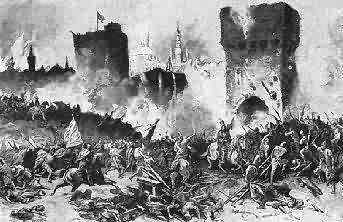
The fall of the Eastern Roman Empire: on 28 May 1453, the Nonwhite Turks began their final assault on the city of Constantinople. With an army in the hundreds of thousands, the city was defended by only some 7,000 White knights drawn from all over Europe, under the command of a Nordic Genoan from northern Italy, Giustinianni. After a furious all night battle, the walls of the city were finally breached at dawn the next day. All the Whites in the city were either massacred or sold into slavery, with a mere handful escaping to tell the dreadful tale. Constantinople was made into a major Muslim center and renamed Istanbul.
Barbaro recorded the last minutes of the last Roman Emperor, Constantine XI, as follows:
"Although he (Constantine XI) clearly saw with his own eyes the danger that threatened the city, and had the opportunity to save himself - as well as many people encouraging him to do so - he refused, preferring to die with his country and his subjects.
"Indeed, he chose to die first, so that he might avoid the sight of the city being taken and of its inhabitants being either savagely slaughtered or shamefully led away into slavery. When he saw that the enemy were forcing him back, and surging through the broken down wall into the city, it is said that he uttered in a great voice, these last words 'The city is taken; and should I still live?' With that he thrust himself into the midst of the enemy and was cut down."
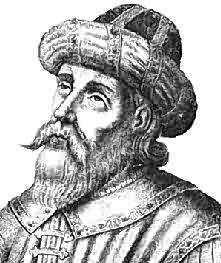
The last Roman Emperor ever - Constantine XI, was killed by Nonwhite Turks when they took the citadel of Constantinople in 1453. With his death formally ended the last vestiges of the mighty Roman Empire, established over 2000 years previously. In reality the original Roman Empire had long since vanished, submerged into the races of a myriad of nationalities.
Barbaro then went on to relate the horror of the Nonwhite sack of the city, scenes which were repeated all over central and southern Europe:
"On 29 May 1453, the Turks entered Constantinople at daybreak. Before they entered the city, the confusion of those Turks and of the Christians was so great that they met face to face, and so many died that the dead bodies would have filled twenty carts.
"The Turks put the city to sword as they came, and everyone they found in their way they slashed with their scimitars, women and men, old and young, of every condition, and this slaughter continued from dawn until midday. Those Italian merchants who escaped hid in caves under the ground, but they were found by the Turks, and were all taken captive and sold as slaves. When those of the Turkish fleet saw with their own eyes that the Christians had lost Constantinople, that the flag of Sultan Mehmed had been hoisted over the highest tower in the city, and that the emperor's flags had been cut down and lowered, then all those in the seventy galleys went ashore . . .
"They sought out the convents and all the nuns were taken to the ships and abused and dishonored by the Turks, and they were all sold at auction as slaves to be taken to Turkey, and similarly the young women were all dishonored and sold at auction; some preferred to throw themselves into wells and drown.
"These Turks loaded their ships with people and a great treasure. They had this custom: when they entered a house, they would at once raise a flag with their own device, and when other Turks saw such a flag raised, no other Turk would for the world enter that house but would go looking for a house that had no flag; it was the same with all the convents and churches. As I understand it, it seems there were some two hundred thousand of these flags on the houses of Constantinople . . these flags flew above the houses for the whole of that day, and for all of that day the Turks made a great slaughter of Christians in the city. Blood flowed on the ground as though it were raining."
CONSTANTINOPLE RENAMED ISTANBUL
Constantinople was made the new Ottoman Muslim capital and renamed Istanbul, a name by which it is still known. Spurred on by this great victory, the Ottomans proceeded in short order to seize all of Greece, Albania and Bosnia. A plan to invade Italy was only aborted after the Ottoman emperor of the time died half way through the planning.

If ruins could talk, what tales they would tell. Many parts of the walls of Constantinople, which withstood countless Nonwhite attacks for nearly 1000 years and which were finally were broken in 1453, are still visible today.
WAR AT SEA - PORTUGUESE CONFRONT TURKS
By 1500, White European explorers had discovered a sea route to the East, and after this year Portuguese fleets began to attack Arab ships in the Indian ocean, seriously affecting the Ottoman's treading routes to the east.
An Ottoman sea fleet was built especially to destroy the Portuguese fleets - several engagements followed, some successful for the Portuguese, others successful for the Turks.
It was only in 1571, that an alliance of White nations, inspired by Pope Pius V with the aid of the Spanish and the Venetians, destroyed Turkish sea power in the Mediterranean at the Battle of Lepanto in that same year.
The Battle of Lepanto saw the two fleets - together comprising at least 500 ships and about 100,000 men - engage each other for a whole day, ending with a great White victory - about 80 Turkish ships were sunk and a further 130 captured. The Turks were routed at sea - a significant event as it marked the first time that the Ottomans had been defeated by a White force.
The psychological effect of this victory upon White Europe was marked - the Spanish writer Cervantes noted in his novel, Don Quixote, that the battle "revealed to all the nations of the world the error under which they had been laboring in believing that the Turks were invincible at sea."
WAR ON LAND - BELGRADE CAPTURED 1521 AD
On land however, the struggle between the various White nations and the Turks continued unabated. In many regions the Turks exacted as cruel a punishment on the locals as they had on the inhabitants of Constantinople.
The Ottomans attempted to lay siege to Belgrade in 1456, but were defeated by a Hungarian national hero, whose name is still celebrated today, Janos Hunyadi. The Ottomans finally seized Belgrade in 1521, and in 1526, the Turks inflicted a crushing defeat on the hastily gathered together Hungarian army at the battle of Mohacs, where the Hungarian King and more than 20,000 White soldiers were killed.
The Turks went on to capture the city of Buda (later to join with a neighboring city, Pest, to become the city of Budapest) in 1526 - but then withdrew from western Hungary, leaving that part to its own devices.
By 1483, the Turks had conquered most of Bosnia and Herzegovina. The two territories remained provinces of the Ottoman Empire for the next 400 years, although unsuccessful uprisings against the Turks occurred frequently during the 19th Century.
Macedonia, bordering on Greece and Turkey, was one of the first territories to fall to the Ottoman invasion - it remained under Turkish rule until the Balkan War of 1912 which saw the Ottomans driven out.
The Turkish Ottoman invasion of 1389, saw the Serbian army defeated at the battle of Kosovo, but sporadic fighting between the White Serbs and the Nonwhite Turks continued till 1459, when the Ottomans captured Smederevo, south of Belgrade. Serbia then came under direct Ottoman rule.
THE FIRST SIEGE OF VIENNA - TURKS SEIZE UKRAINE
In 1521, the Ottomans finally managed to capture Belgrade and the island of Rhodes in 1522. By 1529, the Nonwhite armies had reached Vienna in modern day Austria. By sheer tenacity, the city withheld the siege, and the Ottomans were forced to retreat.
In 1571, the Ottomans seized the island of Cyprus and even began raiding the emerging Russian state to the North East of their extensive empire on the European mainland. In 1661, the Ottomans captured much of present day Ukraine from Poland, and in 1669, conquered the island of Crete. With one great last effort, the Ottomans then re-launched their attack on Vienna in 1683.
THE SECOND SIEGE OF VIENNA - OTTOMANS ROUTED AND WHITE VICTORY CELEBRATED WITH THE CROISSANT
By 1683, the White armies of Europe had prepared their defenses around Vienna well. Their armies routed the Ottomans; with the death blow to the Nonwhite assault being dealt by the arrival of a Polish army (from whom the Ottomans had captured part of the Ukraine).
The great victory feast held by the White armies after this victory led to the origin of the bread now known as a croissant. The victors ordered bread to be made in the shape of the quarter moon shape of the Turkish flag, so that they could physically eat the emblem of the enemy at the feast. From then on the croissant, a curved sickle moon shape bread, became popular in all Europe.
THE WHITES ADVANCE UNDER PRINCE EUGENE OF SAVOY
The Ottomans fell back in confusion - at last the Whites had seized the initiative, and they pressed home their advantage. In 1697, a new Austrian commander, Prince Eugene of Savoy, defeated a huge Ottoman army at Senta in northern Serbia, inflicting massive casualties upon them.
The Ottomans were forced to sue for peace. In terms of the treaty of Karlowitz, the Ottomans were forced to give up substantial parts of Eastern Europe, including Belgrade, to the victorious White army. This was to mark the beginning of the Ottoman retreat from the Balkan Peninsula.
WAR WITH RUSSIA - PETER THE GREAT DEFEATED
The next White nation to wage war on the Ottomans was Russia. The first great Russian-Turkish conflict ended however in defeat for the White forces: the Russian czar Peter the Great's forces were beaten back by a mighty Turkish army at the Battle of Prut River in 1711.
The Ottomans then attacked again up the Balkans, retaking Belgrade in 1739. By threatening Vienna once again, they were able to negotiate a peace treaty from the White powers which allowed them to keep much of their new lands in the Balkans - which by this time had been crisscrossed by Whites and Nonwhites so many times that elements of the population had become mixed themselves.
The Russians waited another three years before relaunching their assault on the Turks: in 1714, a surprise attack saw the Ottomans in Rumania defeated.
THE FRENCH CONNECTION - OTTOMANS HIRE FRENCH MERCENARIES
Then in 1798, the French general Napoleon Bonaparte invaded Egypt with a substantial White French army, easily crushing the branch of the Ottoman Empire ruling that land, which had for centuries been the very center of Islamic power.
Although the French had been motivated not by an anti-Islamic zeal, but rather by an attempt to cut into British supply lines to the East, the effect of a White invasion of Egypt was nonetheless dramatic within the Ottoman Empire - all of a sudden White armies were approaching from all points of the compass.
Realizing that they were facing imminent defeat and that the White powers were now not only technologically ahead, but also in terms of military tactics, the Ottomans hired large numbers of French mercenaries who had served in the French armies and used them to establish military training schools in Turkey.
RENEWED WHITE ASSAULTS SPELL DEATH KNELL FOR OTTOMANS
The improvement in the Ottoman Empire's armies could not however halt the growing power of White resistance in south eastern Europe. After 345 years of subjugation, the Serbs launched a nine year long revolt in 1804, but were suppressed by the Turks in a brutal campaign in 1813. Undeterred, the Serbs launched yet another attempt to eject the Turks in 1815, and this time were successful - within a few months most of Serbia was cleared of Turks.
The Ottomans then accepted the de facto situation and granted Serbia self government. Following the Russian Turkish Wars of 1828 and 1829, Serbia gained even greater autonomy. Finally, the Ottomans withdrew all claims to Serbia in 1867.
Greece became independent in 1829 after launching military campaigns against the Ottomans, backed with material support from both Britain and Russia.
The final blow to the Ottoman military machine was a huge revolt by the White Janissaries in 1826 which ended in the Ottomans having to execute thousands of the White soldiers. In this year the Ottomans finally disbanded the Janissaries.
Fifty years later, a rebellion in Bulgaria saw tens of thousands of Muslims being slaughtered by avenging White mobs: this led to reprisals by Muslims in which tens of thousands of Whites were slain in what became known as the Bulgarian Atrocities.
RUSSO-TURKISH WAR OF 1877
Russia then declared war on the Ottoman Empire in 1877. In a swift campaign, the Russians drove the Ottomans back to Constantinople and forced them to sign the Treaty of San Stefano of 1878, which stripped them of most of their European territories, including Bulgaria, Macedonia and Thrace. Britain gained possession of Cyprus in return for a pledge to the sultan to aid the Ottomans if they needed military assistance in the future, a guarantee that would never be acted upon.
The Ottoman Empire was now in terminal phase. On all fronts the White powers seized territories - Tunisia was taken by the French in 1881, and Egypt (which had briefly been reoccupied by the Ottomans after Napoleon had left) was taken by the British in 1882.
DECLINE AND ALLIANCE WITH GERMANY
In a state of permanent decline, to the point where the Ottoman Empire was referred to as the "sick man of Europe", the Ottoman Turks fished around in the growing turbulence of European politics for aid, finally seizing an offer extended by Germany and the Austro-Hungarian Empire to form an alliance. The latter entered into the alliance to take advantage of the Ottoman's territorial holdings in the Middle East to divert British and French attention - while the Turks used the alliance as a means of obtaining desperately needed supplies of modern munitions and weapons.
Then the Ottomans suffered further territorial setbacks. The Italians invaded the north African port of Tripoli in 1911, and in the Balkans, two separate secessionist wars broke out. These wars not only cost the Ottomans most of their remaining territory in the Balkans, but also saw the killing of virtually every last Turk in the Grecian region of Thrace in 1913.
WORLD WAR 1
When the First World War broke out, the Ottomans were quick to suffer several reverses at the hands of the Allied powers - Russia invaded Anatolia; the British swept up through ancient Sumeria, occupying Palestine and finally Constantinople itself.
The Battle of Gallipoli, where an Allied invasion of the Ottoman Empire was repulsed with serious losses, saw one of the very few Ottoman military victories of the entire war. Only the collapse of the Russian military machine with the Russian Revolution of 1917, saved the Ottoman state from complete dismemberment.
KEMAL ATATURK - A WHITE MAN CREATES MODERN TURKEY
Prominent in the Turkish defense of Gallipoli was a young army officer named Kemal Ataturk - who was very possibly a descendant of one of the Janissaries, having blue eyes and blond hair. Ataturk then went on to seize power in what remained of the Empire, abolishing the Ottoman dynasty in 1919 and declaring the Republic of Turkey in 1923.
Ataturk then launched a program of modernization in his country, using large numbers of Europeans in this process. It was a supreme act of irony that a White man eventually led the Nonwhite Turks into the modern world - a mixed race who had been responsible for the longest and most effective race war against Europe till that time.
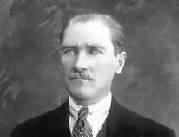
Kemal Ataturk - the White creator of modern Turkey. To this day there are strong pockets of Whites left in Turkey, mostly descendants of the Janissaries.
THE OTTOMAN LEGACY
The Ottoman Turks were the last of the Asian invaders of Europe to use violence as their passport of entry, but they were also significant for another reason: the sheer length of the time of their occupation of the Balkans left a large number of the inhabitants of the Balkan peoples with Turkish blood in their veins, as can be seen to this day, as many inhabitants of the region are not only Muslim in faith, but are also distinctly darker than other Balkan residents.
or back to
or
All material (c) copyright Ostara Publications, 1999.
Re-use for commercial purposes strictly forbidden.